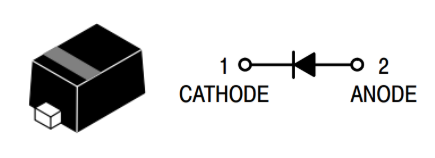
The RB521S30T1G is a Schottky barrier diode for high-speed switching, circuit protection, and voltage clamping applications. Its extremely low forward voltage minimizes conduction loss, improving efficiency in power-sensitive circuits. Additionally, with the miniature surface-mount package, it is good for compact, portable, and hand-held devices where space is a key constraint.

Cathode (1) – The negative terminal, where current flows out of the diode.
Anode (2) – The positive terminal, where current enters the diode.



| Parameter | Value |
| Diode Type | Schottky Barrier Diode |
| Maximum Reverse Voltage | 30V |
| Forward Voltage (V_F) @ I_F = 200mA | 0.38V (typical) |
| Average Rectified Current | 200mA |
| Voltage - Forward (Vf) (Max) @ If | 500 mV @ 200 mA |
| Reverse Current (I_R) @ V_R = 10V | 1.0µA (max) |
| Current - Reverse Leakage @ Vr | 30 µA @ 10 V |
| Power Dissipation (P_D) | 200mW |
| Speed | Small Signal =< 200mA (Io), Any Speed |
| Operating Temperature | -55°C ~ 125°C |
| Package Type | SOD-523 |
Extremely Fast Switching Speed
Extremely Low Forward Voltage 0.5 V (max) @ IF = 200 mA
Low Reverse Current
NSV Prefix for Automotive and Other Applications Requiring Unique Site and Control Change Requirements; AEC−Q101 Qualified and PPAP Capabl
These Devices are Pb−Free, Halogen Free/BFR Free and are RoHS Compliant*
High-Speed Switching Circuits
Voltage Clamping
Rectification in Low Voltage Circuits
Circuit Protection
Portable and Handheld Devices
RF and Communication Circuits
Here are some alternative Schottky barrier diodes to the RB521S30T1G from the same series or with similar characteristics:
RB520S30T1G
RB522S30T1G
RB521S40T1G
RB520S40T1G
RB551V-30
RB751S30T1G
These alternatives offer similar low forward voltage and fast switching capabilities, making them suitable for circuit protection, rectification, and voltage clamping applications.

Using the RB521S30T1G Schottky diode is quite simple. First, identify the terminals— the anode (+) and the cathode (-), with the cathode usually marked by a band. When integrating it into a circuit, the connection depends on the application.
For rectification, connect the anode to the AC or DC input and the cathode to the output. If using it for reverse polarity protection, place it in series with the power supply, with the anode to the positive voltage and the cathode to the load. In clamping or protection circuits, the cathode is typically connected to the signal line, while the anode goes to ground.
The RB521S30T1G comes in a SOD-523 package, which is an ultra-miniature surface-mount design. This tiny footprint makes it perfect for circuits like handheld devices and portable electronics.
Since it's an SMD (Surface-Mount Device), soldering needs to be precise — too much heat can damage the diode. It's best to use reflow soldering or a fine-tip soldering iron with controlled temperature. Once mounted, the SOD-523 package ensures strong electrical connections while keeping the overall design lightweight and efficient.

The RB521S30T1G is made by Onsemi, a well-known semiconductor manufacturer specializing in power and signal management solutions. They're big in the game when it comes to energy-efficient electronics, supplying components for everything from automotive and industrial systems to consumer gadgets.
It’s a Schottky diode designed for high-speed switching, circuit protection, and voltage clamping, commonly used in portable devices and low-power applications.
It has two pins: Anode (+) and Cathode (-). Current flows from the anode to the cathode when forward biased.
Compared to standard silicon diodes, it has a much lower forward voltage drop and faster switching speed, improving efficiency in low-voltage circuits.